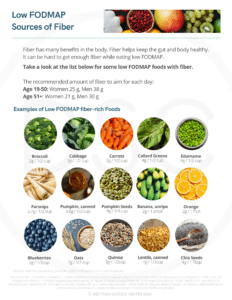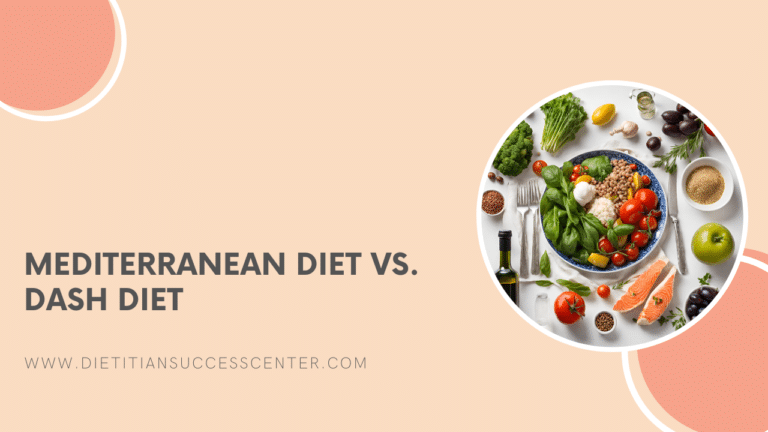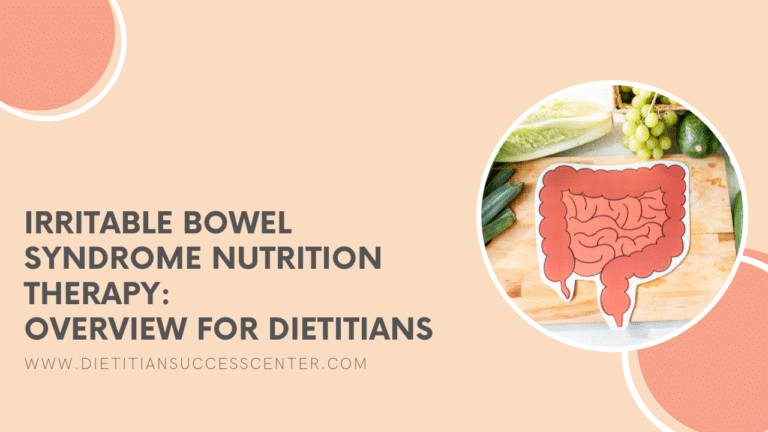

Written by Olivia Farrow, RD, MHSc
Reviewed by Maria Dellanina, RDN
Helping your client or patient find the right balance of fiber while adhering to a low FODMAP diet can be challenging. But fear not, we’ve compiled a list of high fiber, low FODMAP foods that you can recommend to your clients, ensuring they maintain a happy gut without compromising on nutrition.
First, what is “Low FODMAP”?
Digestive symptoms can be debilitating and greatly impact quality of life. The FODMAP diet is an evidence-based elimination diet that can be implemented for identifying individual food triggers (1,2). Dietitian support is recommended for implementing a low FODMAP diet and can improve adherence to the diet stages and treatment response (3).
The Low FODMAP elimination diet is not intended for a lifetime commitment. It serves as a temporary strategy to systematically test foods to find the right balance for managing an individual’s digestive symptoms.
It focuses on three stages:
- Low FODMAP Diet (2-6 weeks): Restricting moderate and high FODMAP foods to achieve approximately 80% symptom improvement.The dietitian guides clients in finding suitable substitutions and monitoring food journals.
- FODMAP Reintroduction (6-8 weeks): Systematic testing of FODMAP foods with increasing serving sizes, while continuing a low FODMAP diet.
- Personalization (Ongoing): Reintroducing tolerated foods to achieve a balanced, individualized diet while maintaining symptom control. This ongoing stage represents how the individual will eat in the long term.
So, What are FODMAPs?
FODMAP stands for Fermentable, followed by the specific carbohydrates (1,2):
-
- Oligosaccharides, which include:
-
- Fructans – commonly found in certain fruits, garlic, onion, and some grains (e.g. wheat)
-
- Galactooligosaccharides (GOS) – found in legumes (e.g. kidney beans), nuts (e.g. cashews)
-
- Oligosaccharides, which include:
-
- Disaccharides
-
- Lactose is the disaccharide commonly found in dairy
-
- Disaccharides
-
- Monosaccharides
-
- Fructose, which is primarily found in certain fruits (e.g.. mango), vegetables (e.g. asparagus), sweeteners (e.g. honey)
-
- Monosaccharides
-
- Polyols (also known as sugar alcohols)
-
- Sorbitol (stone fruits, e.g. peaches, plums) and sweeteners (mannitol, xylitol, lactitol, isomalt)
-
- Polyols (also known as sugar alcohols)
These short-chain carbohydrates are poorly absorbed by the small intestine. Instead, they travel to the large intestine, where they are fermentable (bacteria feed on them and create gas as a byproduct) and osmotically active (they draw liquid into the gut).
Understanding how certain quantities and types of FODMAPs impact an individual can help uncover their individual threshold and manage symptoms.
It is nearly impossible to guess the FODMAP content of foods. Most foods need to have their FODMAP content quantified and measured in a laboratory setting (2). Monash University conducts these types of assessments in its research facility and classifies certain serving sizes of foods as “low,” “moderate” or “high” FODMAP.
Monash University has an app that is the most reliable source of FODMAP foods; the app is frequently updated and is the most accurate source of FODMAP food information.
Why Does Fiber Matter on a Low FODMAP Diet?
Fiber can be reduced on both a FODMAP elimination diet and a low FODMAP personalized maintenance diet because foods high in fiber also tend to contain FODMAPs. Fiber plays an important role in the gut microbiome (4). It also aids in digestion, regulates blood sugar levels, and helps prevent constipation.
For individuals on a low FODMAP diet, achieving the recommended daily fiber intake can be tricky. Let’s delve into the world of low FODMAP fiber and discover some delicious options.
Low FODMAP Fiber Foods
Here’s a handy list of low FODMAP fiber foods that your clients can incorporate into their diet.
An important consideration is that most foods on this list are only considered “low FODMAP” at or under a certain serving size and some foods may still be symptom-triggers at low serving sizes for some individuals.
Carrots
2 grams of fiber and low FODMAP for 1 medium.
Provide a crunch with carrots. A vibrant addition to your clients’ diet with a unique blend of flavor and color.
Collard Greens
8 grams of fiber and low FODMAP for 1 cup.
Collard greens can serve as a fantastic side dish, bringing both flavor and a wealth of nutrition to your clients’ meals.
Edamame
4 grams of fiber in ½ cup, low FODMAP for ½ cup or less.
The fiber-packed goodness of edamame makes it an excellent choice for clients also aiming to incorporate more plant-based protein into their diets.
Parsnips
3 grams of fiber, low FODMAP for 1 medium.
Parsnips have a sweet, earthy flavor and are excellent roasted or in soups or stews.
Pumpkin Seeds
2 grams of fiber, low FODMAP for 2 tbsp.
Pumpkin seeds offer an easy source of fiber, protein, zinc and crunch! They taste great sprinkled on yogurt, salads, and even ice cream.
Blueberries
4 grams of fiber, low FODMAP for 1 cup.
Blueberries can provide a delicious, sweet, colorful, and fiber-rich addition to a low-FODMAP diet.
Oats (Rolled)
2 grams of fiber, low FODMAP for ½ cup.
Oats are so versatile and taste great sweet or savory. The soluble fiber may also help some individuals with managing diarrhea.
Quinoa
6 grams of fiber, low FODMAP for 1 cup cooked.
Quinoa makes a great addition to any meal and can be an excellent alternative or addition to rice-dishes to add some extra nutrition and variety.
Chia Seeds
8 grams of fiber, low FODMAP for 2 tbsp.
Chia seeds provide ALA omega-3 fatty acids and are a source of soluble fiber. They’re also super versatile. They can be made into chia pudding, added to beverages, or sprinkled into yogurt, oatmeal, and even soups.
Become a DSC member today to grab your copy of our Low FODMAP, High Fiber Foods client handout with 15 examples of low fodmap, high fiber foods that you can use with your clients!

Encourage your clients to diversify their low FODMAP diet by incorporating these fiber-rich options. Share this information and guide them towards achieving the recommended daily fiber intake. Remember, promoting gut health doesn’t mean compromising on taste and nutrition. Let’s empower our clients to make informed, flavorful choices and lead a healthy, balanced life. There are fiber-friendly food options on the low FODMAP journey!
Disclaimer: the information provided in all written materials is for educational purposes only and is not to be used as medical advice or to diagnose or treat a medical disease. It is strictly for informational purposes and is general in nature. Dietitian Success Center Inc. is not responsible and cannot be held liable for any actions or inactions taken related to the information provided. Consult with your local medical provider before implementing any dietary changes. It is hereby understood that the information provided does not replace medical advice provided by your healthcare provider.
References
*FODMAP data from: Monash University “Monash Uni Low FODMAP Diet” Google Play Store, Vers. 3.1.1. Accessed January 29, 2024 https://play.google.com/store/apps/details?id=com.monashuniversity.fodmap&hl=en_CA&gl=US
*Fiber data from Canadian Nutrient File. “Canadian nutrient file search engine online.” (2015) and US Department of Agriculture. “FoodData Central.” (2019). Fdc.nal.usda.gov
- Black, Christopher J et al. “Efficacy of a low FODMAP diet in irritable bowel syndrome: systematic review and network meta-analysis.” Gut vol. 71,6 (2022): 1117-1126. doi:10.1136/gutjnl-2021-325214
- Gibson, Peter R, and Susan J Shepherd. “Evidence-based dietary management of functional gastrointestinal symptoms: The FODMAP approach.” Journal of gastroenterology and hepatology vol. 25,2 (2010): 252-8. doi:10.1111/j.1440-1746.2009.06149.x
- Sultan N, Varney JE, Halmos EP, Biesiekierski JR, Yao CK, Muir JG, Gibson PR, Tuck CJ. How to Implement the 3-Phase FODMAP Diet Into Gastroenterological Practice. J Neurogastroenterol Motil. 2022 Jul 30;28(3):343-356. doi: 10.5056/jnm22035. PMID: 35799231; PMCID: PMC9274476.
- Hill, Peta, Jane Muir, and Peter Gibson. “Controversies and Recent Developments of the Low-FODMAP Diet.” Gastroenterology and Hepatology 13, no. 1 (January 2017): 36–45. https://doi.org/https://www.ncbi.nlm.nih.gov/pmc/articles/PMC5390324/.








